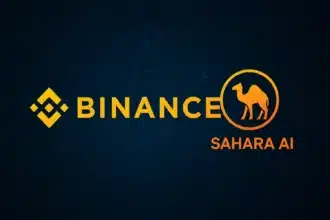Cryptocurrency just got a whole lot easier for Swiss bank customers. PostFinance, one of Switzerland’s leading banks, has rolled out Ethereum staking, letting customers earn passive income without breaking a sweat. Let’s break down why this matters and what it means for both seasoned crypto enthusiasts and everyday folks dipping their toes into digital assets.
Ethereum Staking Now at Your Fingertips
Here’s the scoop: PostFinance’s new Ethereum staking feature allows customers to lock up their ETH (Ethereum) and earn staking rewards. For the uninitiated, staking is like putting your money in a high-tech savings account. Instead of interest, you earn rewards for helping secure the Ethereum blockchain. Cool, right?
The best part? You don’t need a mountain of ETH to get started. The minimum deposit is just 0.1 ETH, which is a fraction of what many platforms require. With current prices, that’s affordable for most folks keen on exploring crypto without going all-in.

PostFinance’s Alexander Thoma, Head of Digital Finance, emphasized transparency and ease of use.
“The ‘staking’ service is completely integrated into PostFinance’s existing services,” Thoma shared. “This means that customers can see their ‘staking rewards’ directly in their asset statement, together with their other crypto assets.”
Why This Matters
Crypto staking has been around for a while, but this move by PostFinance is a big deal. Why? Because it’s bringing crypto to the masses in a way that’s user-friendly and secure. Swiss banks are known for their reliability, and PostFinance’s partnership with Sygnum, a regulated digital asset bank, doubles down on that reputation.

Security and transparency are huge selling points here. Since the staking happens directly on the Ethereum blockchain, users can trust that their assets are being handled with care. Plus, staking rewards are tracked in real-time, so there’s no guesswork involved. It’s all about peace of mind.
Looking Ahead: What’s Next for PostFinance?
Right now, Ethereum is the only player in the staking game at PostFinance. But the bank isn’t stopping there. They’ve hinted at expanding their staking services to other cryptocurrencies down the line. While details are still under wraps, this forward-thinking approach shows PostFinance is serious about staying ahead of the curve.
Imagine staking Solana, Cardano, or Polkadot alongside Ethereum. That’s where things could be headed. And let’s be real—options like these could make crypto even more appealing to a broader audience.
Switzerland’s Crypto Revolution
PostFinance’s Ethereum staking launch isn’t happening in a vacuum. Switzerland has been making waves in the crypto space for years, earning its reputation as a global crypto hub. From “Crypto Valley” in Zug to forward-thinking legislation, the country’s all in on digital assets.
But there’s more. Recently, Swiss legislator Samuel Kullmann proposed adding Bitcoin to the Swiss constitution. Yep, you read that right. The plan is to gather 100,000 signatures to trigger a public vote. Talk about thinking big!
This proposal could put Switzerland on an even higher pedestal in the crypto world. And if Bitcoin makes it into the constitution? Well, let’s just say it would be a mic-drop moment for the industry.

What Does This Mean for You?
So, why should you care about PostFinance’s new Ethereum staking service? If you’re in Switzerland, this could be your golden ticket to earning passive income with minimal hassle. But even if you’re outside Switzerland, it’s a sign of where the banking world is headed. Traditional banks are waking up to the potential of crypto, and that’s great news for anyone already invested in digital assets.
Think about it: If one Swiss bank does this, others are bound to follow. And when traditional banks start embracing crypto, it’s a win for mainstream adoption. Plus, it opens up opportunities for people who’ve been hesitant to jump into crypto because they find it too complicated or risky.
The Bigger Picture
Let’s zoom out for a second. PostFinance’s Ethereum staking isn’t just about offering a new service. It’s about bridging the gap between traditional finance and the crypto world. It’s about making digital assets accessible to everyone, not just tech geeks or early adopters.
And with Switzerland’s broader push for crypto adoption—from PostFinance’s initiatives to proposals like Kullmann’s—it’s clear that the future of finance is digital. Whether you’re already in the crypto game or just starting to explore, this is a trend you don’t want to ignore.
Wrapping It Up
PostFinance’s Ethereum staking launch is a big win for crypto enthusiasts and a step toward mainstreaming digital assets. With its user-friendly integration, transparent rewards tracking, and promise of future expansion, this service has the potential to attract a whole new wave of crypto users.
So, what’s next for crypto in Switzerland and beyond? One thing’s for sure: PostFinance’s move is just the beginning. Whether you’re staking Ethereum today or watching Bitcoin debates tomorrow, it’s an exciting time to be part of the crypto revolution.
Stay tuned to The BIT Journal and keep an eye on Crypto’s updates. Follow us on Twitter and LinkedIn, and join our Telegram channel to be instantly informed about breaking news!
FAQs on PostFinance’s Ethereum Staking
1. What is Ethereum staking, and why should I care?
Ethereum staking lets you lock up your ETH to support the Ethereum blockchain and earn rewards. It’s a simple way to earn passive income without actively trading crypto.
2. How much Ethereum do I need to start staking with PostFinance?
The minimum deposit is just 0.1 ETH, making it accessible even for those new to crypto.
3. Is staking with PostFinance safe?
Yes! Staking is conducted directly on the Ethereum blockchain, and PostFinance integrates it into its secure, regulated platform for transparency and reliability.
4. Can I stake other cryptocurrencies with PostFinance?
Not yet. Currently, staking is limited to Ethereum, but PostFinance plans to add more cryptocurrencies in the future. Stay tuned!






























